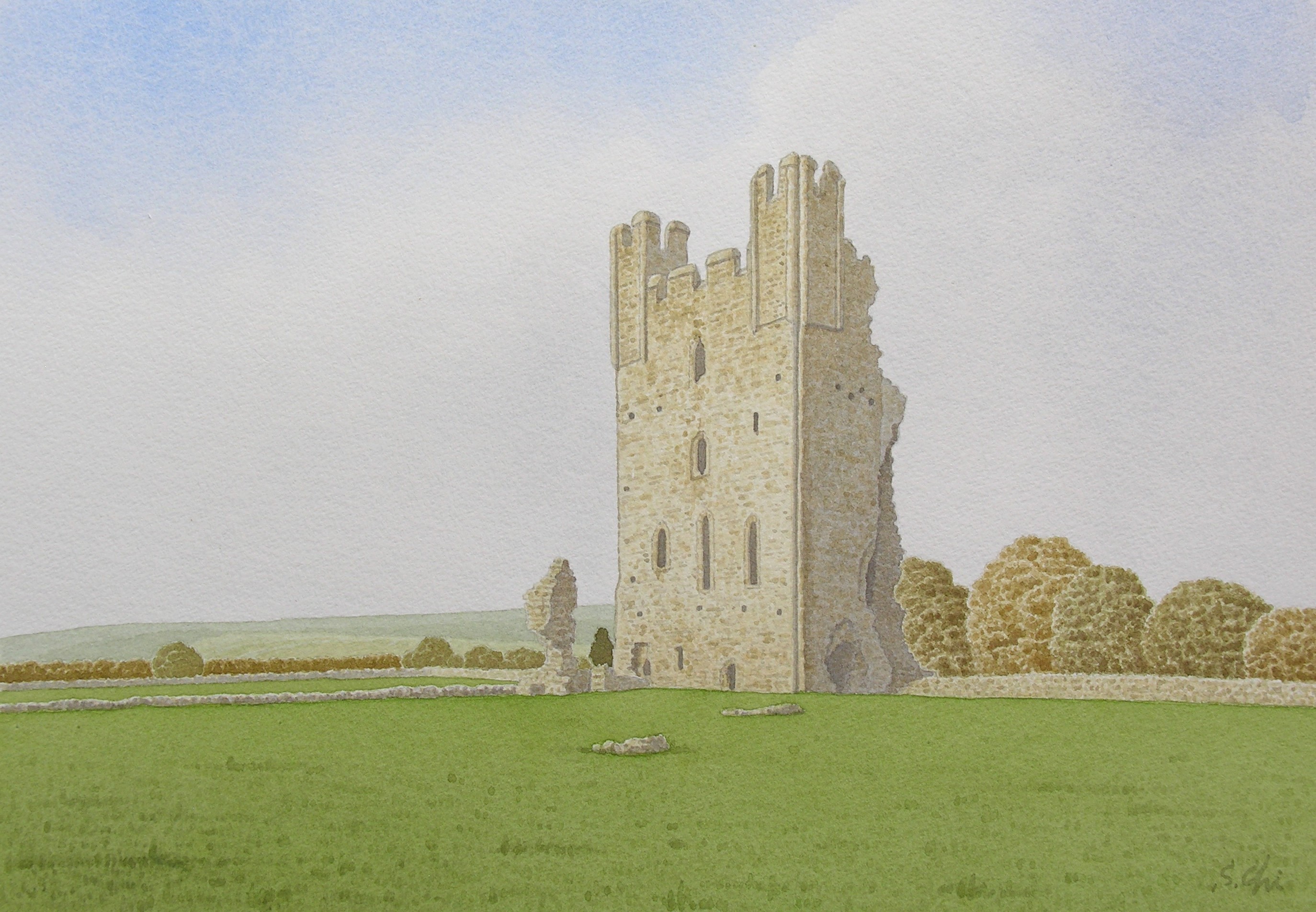
遥かなる わがヨークシャー (Faraway My Yorkshire)
ノース・ヨーク・ムーアズ (The North York Moors)
76 ヘルムズリー城 [ヘルムズリー] (Helmsley Castle, Helmsley)

ヨークシャーには、わたしが知るだけで、18カ所に城の廃墟がある。
リーヴォ修道院から東へ3kmほど行ったところには、ヘルムズリー城の廃墟がある。
この城は、12世紀の終わりから13世紀のはじめにかけて、ヘルムズリー卿ロバート・ドゥ・ルースによって築かれたものである。
14世紀には、東側のキープ(天主閣)と対になった「西の塔」があり、それらを、二つのゲイトハウス(門楼)と一つのバービカン(外防備)、三つの塔をそなえた城壁がとりかこんでいた。さらにその外側には、二重に濠がめぐらされているという、強固な城であった。
しかしいまは、城をまもるべき城壁も失い、キープが剥き出しとなった廃墟になっている。またそのキープも――この水彩画に描いたように――西側の半分とその上の二つの望楼のみを残し、東側の半分は無残にも崩れ落ちている。城の廃墟ならではの、劇的な姿である。
この城は、一時グロスター公リチャード(のちのリチャード3世)の城になったこともある。また17世紀には、初代と2代のバッキンガム公ジョージ・ヴィリーアーズ父子の城になっていた。
ピューリタン革命のときには、1644年7月2日のマーストン・ムーアの戦いに敗れた国王軍のサー・ジョーダン・クロスランドが、部下とともにこの城に立てこもることがあった。そして、ヨークシャー議会軍総司令官のサー・トマス・フェアファックス(彼はヨークシャーの人間で、「ブラック・トム」と呼ばれた気骨のある武人)に率いられた議会軍に包囲され、はげしい砲撃をうけた。
この砲撃でヘルムズリー城は城壁を失い、修復が困難なまでに破壊された。それ以来、放棄され、廃墟になっていった。
ピューリタン革命で国王軍の敗北が色濃くなったとき、チャールズ1世の息子――のちのチャールズ2世――をフランスに連れだしたのは、2代バッキンガム公であった。
バッキンガム公は1657年にイングランドに戻ってきて結婚したが、皮肉なことにその相手は、父から相続したこの城を13年前に攻撃して破壊したサー・トマス・フェアファックスの娘メアリーであった。ここにも、国王軍と議会派との、興味深い和解が見られる。
ピューリタン革命では、国王軍がたてこもった多くの城が、議会軍の砲撃をうけて破壊された。
リーズの南東およそ20kmのところに、ポンティフラクト城の廃墟がある。この城は、ウィリアム1世が戦略拠点の一つとして、ノルマン人貴族で従臣でもあったイルバート・ドゥ・レイシーに築かせたものに起源をもつ。王城の一つで、中世でもっとも強固でもっとも美しい城だったとされ、宮廷の一つでもあった。1630年ごろに描かれた絵には、四隅に円筒形の塔をもつ巨大なキープと、六つの四角い塔がつらなった城壁が描かれており、大規模な城であったことがわかる。
このポンティフラクト城は、廃位されたリチャード2世が、1400年に殺害されたところとしても知られている。シェイクスピアの一連の史劇にも、古い呼び名の「ポンフレット城」として登場してくる。
リチャード2世の話ばかりでなく、ポンティフラクト城には、暗い記録が残されている。
1321年にエドワード2世にたいして反乱を起こし、翌年の3月16日のバラブリッジの戦いで国王軍に敗れたランカスター伯トマスが3月22日に処刑されたのは、ポンティフラクト城であった。
スコットランドのジェイムズ1世(在位1406-37)は、18年間もイングランドで人質としての生活を強いられたが、ポンティフラクト城に幽閉されていたときもあった。
また、英仏間の「百年戦争」の時代、1415年のアジャンクールの戦いでイングランドに負けたフランスのオルレアン公シャルルは、彼の騎士たちとともにここに囚われていた。
グロスター公リチャード――のちのリチャード3世――が1483年に、甥のエドワード5世の側近で反リチャード派だったリヴァース伯アンソニー・ウッドヴィルやサー・リチャード・グレイ、サー・トマス・ヴォーガンらを処刑したのも、ここであった。
ポンティフラクト城は、華麗な宮殿にして牢獄、そして処刑場と、まさに北のロンドン塔だったのである。
この城もピューリタン革命で破壊され、いまはわずかに基礎の石を残すのみである。
城の廃墟にあるものは、過去の栄光、敗れ去った者たちの怒り・悲しみ・無念さ、それらをすべて飲み込んだ虚しさである。
城の廃墟に立って思い出されるのは、杜甫の詩の一節「国破れて山河あり、城春にして草青みたり」である。
As far as I know, there are 18 ruins of castles in Yorkshire.
Two miles to the east of Rievaulx Abbey, there are the ruins of Helmsley
Castle.
This castle was built from the end of the 12th century to the early 14th
century. Once there was the West Tower twined with the keep. They were
surrounded by the curtain walls with two gatehouses, one barbican and three
towers. Bouble ditches were dug in the outside of the curtain walls.
Helmsley Castle was a strong castle, but today the keep, having lost the
half of its eastside, stands without curtain walls. Its appearance is very
dramatic.
This castle was once owned by Richard, Duke of Gloucester. In 17th century,
it was owned by George Villiers, 1st Duke of Buckingham and his son, 2nd
Duke with the same name.
During the Civil War, Helmsley Castle was held by Sir Jordan Crosland, a Royalist for three months after the Royalists were defeated by the Parliamentarians at the Battle of Marston Moor on the 2nd of July in 1644. The Castle was sieged by the Yorkshire Parliamentarians Army commanded by Sir Thomas Fairfax, called "Black Tom", and destroyed severely, ruling out any possibility of restoration. After the Civil War, the castle was abandoned to become ruins.
It was the 2nd Duke of Buckingham who took Prince Charles, afterwards King
Charles II, to France when the Civil War being lost by the Royalists.
The Duke came back to England in 1657 and married Mary, a daughter of Sir
Thomas Fairfax who had besieged the castle once.
I can see here an interesting reconciliation between the Royalist and the
Parliamentarian.
During the Civil War, many castles held by the Royalists were besieged
by the Cromwellians and became ruins.
Pontefract Castle, lying 12 miles to the southeast of Leeds, its original
castle built by Ilbert de Lacy, was one of the royal castles and also one
of the strongest and most beautiful mediaeval castles. It is the place
where the deposed Richard II was murdered in 1400. This castle appears
in Shakespeare's historical plays as Pomfret Castle. This castle also suffered
sieges three times and was almost levelled by decree of Cromwell after
the execution of Charles I.
Standing at ruined castles, I would often remember a part of poem by Tu
Fu, a Chinese poet (712-770).
"Countries may fall, but their rivers and mountains remain: when spring
comes to the ruined castle, the grass is green again."
(Translated by Donalds Keene)